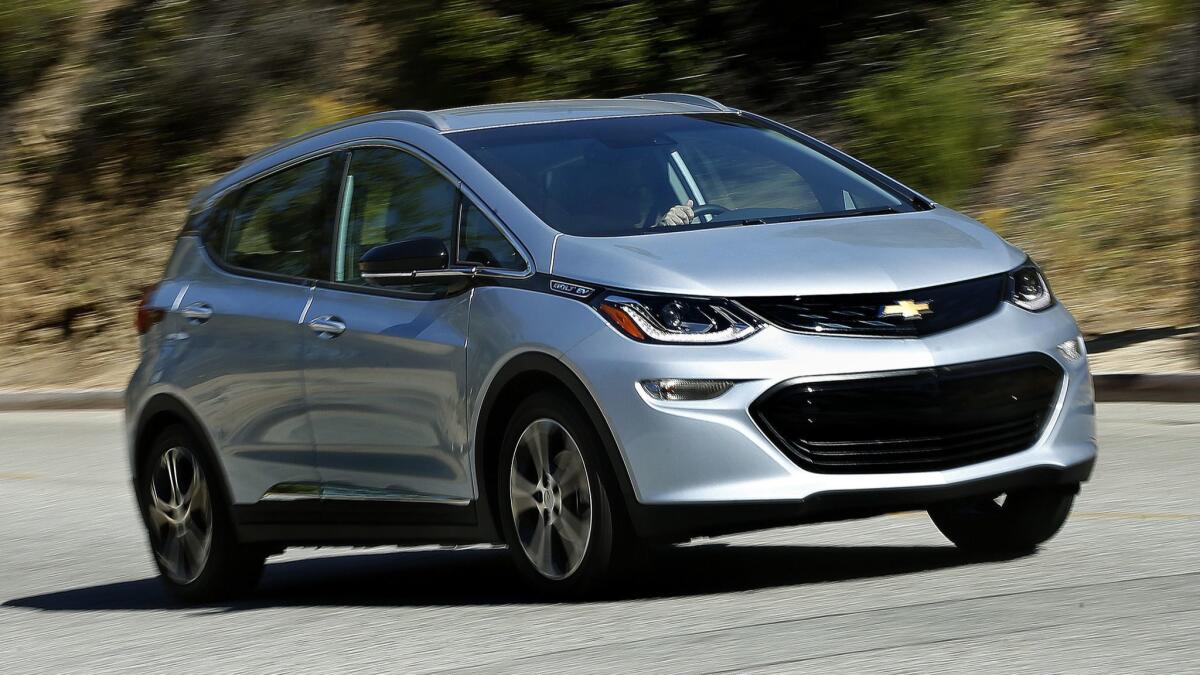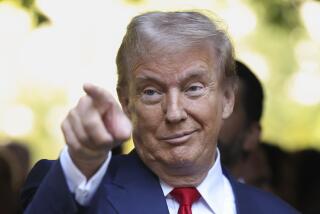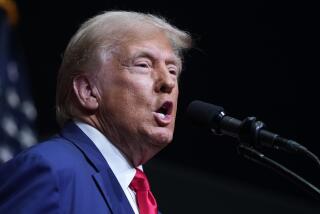Trump threatens to kill GM’s electric-vehicle subsidies. But even presidents can’t stop market forces

Donald Trump can fret over General Motors Co.’s plan to close plants, slash jobs and ditch models. He can even threaten, as he did Tuesday.
But market forces are tough to beat, even if you’re president.
Trump captured the White House thanks in large part to the story he told — that he could reverse America’s industrial decline. He promised to bring back manufacturing and fossil-fuel jobs written off as casualties of global trade and overregulation.
But almost halfway through Trump’s first term, divergences from his “Make America Great Again” story line continue to pile up, pushed along by technology, globalization and a changing climate.
Trump is fighting back. On Tuesday, the day after GM’s announcement, he tweeted out threats to cut all the subsidies GM receives, including tax breaks for electric vehicles. Larry Kudlow, director of the White House National Economic Council, also piled on: “There’s great disappointment that it seems like GM would rather build its electric cars in China rather than the United States,” Kudlow told reporters at a briefing just before Trump’s tweets.
GM’s stock price fell 2.6% Tuesday, to $36.69, wiping out much of its gain from the day before. Monday’s rally was linked to Chief Executive Mary Barra’s plan to boost cash flow by shutting plants in the United States and Canada, laying off thousands of workers and jettisoning struggling sedans from the company’s lineup.
Trump wasn’t specific about the subsidies he was referring to, but consumers are eligible for a $7,500 federal tax credit toward the purchase of electric vehicles such as the Chevrolet Bolt. GM is nearing a sales limit for the number of EVs that are eligible for that incentive before it starts to wind down over the course of more than a year.
It’s unclear whether Trump has the authority to revoke subsidies without action by Congress. It’s also difficult, if not impossible, for Trump to overcome the dynamics that are driving companies to choose robots over humans, discontinue brands and close plants. Some are choosing to build closer to their consumers and supply chains, including China, while others are moving production lines to lower-cost countries, such as Mexico.
Consumers, too, are increasingly switching to alternative energy for cars and homes. As wages finally rise, people are also buying more imported goods, which pushes up the U.S. trade deficit, one metric by which Trump assesses the economy.
“The market is a tsunami,” said Seth Kaplowitz, a finance lecturer at San Diego State University. “If you surf it, you’ll be fine, but if you push back, it’s too strong.”
Trump has gone to great lengths to revive once-storied industries. America’s steel and aluminum companies won levies to hamper foreign competitors. He hit Whirlpool’s biggest rival, South Korea’s Samsung Electronics Co., with tariffs on washing machines. For coal miners, Trump is proposing to reduce Obama-era environmental regulations. He also billed his corporate-tax cut as an elixir for capital spending and job creation.
Sometimes, Trump has offered an explicit quid pro quo. For GM and other automakers, he pledged to lower fuel economy standards in return for jobs. His administration is also considering tariffs on imported autos and parts on national security grounds.
All of this is on top of the president’s biggest push to revive industry: starting a trade war with China, America’s largest commercial partner.
Market forces, however, have proved too powerful. For Barra, the plan to close a handful of older plants and dismiss more than 14,000 employees came down to basic economics. Consumers are expected to shift to electric and autonomous vehicles. They’re also shunning small cars, like GM’s Chevy Cruze, in favor of pickups and SUVs. With some factories down to one shift a day, GM said it needed to cut its capacity to make traditional passenger cars, while keeping lower-cost production in Mexico.
These moves drew the ire of the president, who said: “We have a lot of pressure on them” to maintain operations in places such as Ohio — a state key to his reelection. “You better get back in there soon — that’s Ohio.”
GM’s restructuring comes less than two years after Trump praised the company for promising to invest $1 billion in its U.S. operations. It was one of many such pledges by large companies — even though some were reiterating existing plans — meant to gain favor with the new administration. The jobs GM promised, however, have largely gone to Silicon Valley, where it’s developing autonomous vehicles.
Like GM, Ford Motor Co. said it will exit much of the passenger-car market to focus on SUVs and trucks. It also has said it will lay off workers as part of an $11-billion restructuring.
Jawboning aside, Trump was unable to stop job losses at a Carrier Corp. air conditioning plant in Indianapolis. Soon after winning office, he made a highly publicized visit to the factory in a bid to stop Carrier from moving positions to Monterrey, Mexico. The company kept the plant open after receiving millions in state subsidies. But about 600 workers ended up losing their jobs anyway.
The United States still is a manufacturing heavyweight, but companies increasingly are choosing automation over human labor. Some forces buffeting manufacturers are the result of other Trump policies. He has worked to lower oil prices by cutting environmental rules and pressuring petrostates. U.S. consumers have responded by purchasing yet more SUVs and trucks, which accounted for about 65% of new-vehicle sales in September. Tariffs have also raised prices on aluminum and steel, forcing up production costs.
The decision by Harley-Davidson Inc., once Trump’s model of a patriotic American manufacturer, to shift motorcycle production to Europe came in direct response to Trump’s tariffs, which prompted the European Union to retaliate with duties of its own, damaging sales there.
Whirlpool at first welcomed Trump’s tariffs by adding 200 jobs in the United States. It was hurt months later by levies on steel and aluminum, which raised the cost of raw materials. The company said it was forced to pass those costs to customers by raising prices, a move that battered sales and resulted in a profit warning and a steep slide in shares.
Just hours after GM’s announcement Monday, Trump told supporters at a rally in Biloxi, Miss., that they shouldn’t worry. “Under my administration, we’ve created 600,000 brand-new manufacturing jobs that people said could never come back to our country.”
Not quite. Since Trump took office, the U.S. Department of Labor reports, companies have added just over 400,000 manufacturing jobs — tiny compared with 150 million non-farm positions. Coal-mining jobs have also increased, but by fewer than 2,000 slots.
Early on, Trump’s corporate tax cut appeared to boost capital spending, but that may have been short-lived. Companies are reacting more to market conditions than the tax law, such as by paying more because labor is tight. One measure of U.S. business investment shows it at the same level as before the tax cuts. In the end, Kaplowitz said, companies are concerned with profitability and survival over allegiance to a country or politician.
Trade-deficit numbers are telling. The gap between what the United States sells abroad and what it buys from other countries has ballooned under Trump. In September, the deficit was $54 billion, up $700 million from August and a seven-month high. In the year to date, the deficit has increased by $40.7 billion, or 10%, from the same period in 2017.
Trump isn’t deterred, at least publicly. “They said manufacturing jobs would never come back, you’d need a magic wand,” he said in Biloxi. “Well, we found the magic wand.”
Mr. Market begs to disagree.
UPDATES:
2:45 p.m.: This article was updated with analysis of President Trump’s industrial policy and other examples of companies moving factories or cutting jobs.
This article was originally published at 1:05 p.m.






